While traditional hiking gear fills our landfills, eco-conscious alternatives fill our trails with purpose. We’ve entered an era where sustainable outdoor equipment isn’t just a trend – it’s a necessity. As hikers and stewards of nature, we’re facing a choice between perpetuating environmental damage or embracing gear that aligns with our outdoor values. Let’s explore how switching to sustainable hiking equipment transforms our impact from destructive to regenerative.
The Evolution of Sustainable Hiking Backpacks
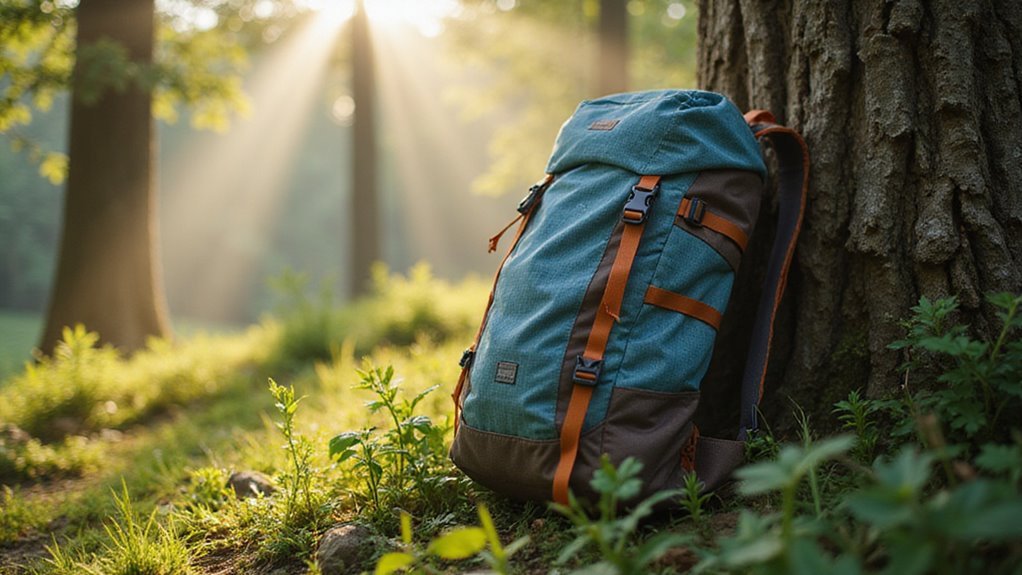
While outdoor enthusiasts once had to choose between performance and sustainability, today’s hiking backpacks prove we can have both. Leading brands have revolutionized eco-friendly gear through recycled polyester and sustainable materials that slash environmental impact without compromising function.
We’re seeing game-changing sustainable practices from companies like Gregory, who’ve cut shipping waste by 21%. Their commitment to sustainability shows in innovations like PFC-free water repellents and ventilated suspension systems. Additionally, many of these brands are utilizing recycled materials that significantly reduce energy consumption and pollution during production.
These aren’t just empty green promises – they’re engineering triumphs that minimize waste while maximizing performance. It’s time we embrace these advances in outdoor gear that protect both our adventures and our planet.
Environmental Benefits of Eco-Friendly Materials
When we choose eco-friendly materials for hiking gear, we’re not just making a fashion statement – we’re delivering a knockout punch to pollution and resource waste.
These sustainable materials transform fishing nets into recycled nylon, turning ocean trash into trail-worthy treasures.
We’re talking biodegradable materials that won’t haunt landfills for centuries, and durable materials that laugh in the face of wear and tear.
By minimizing our environmental footprint through smarter material choices, we’re reducing waste at every step.
The bonus? Our gear uses less water and energy to produce, making every hike a win for Mother Nature.
Top Brands Leading the Sustainable Pack Movement
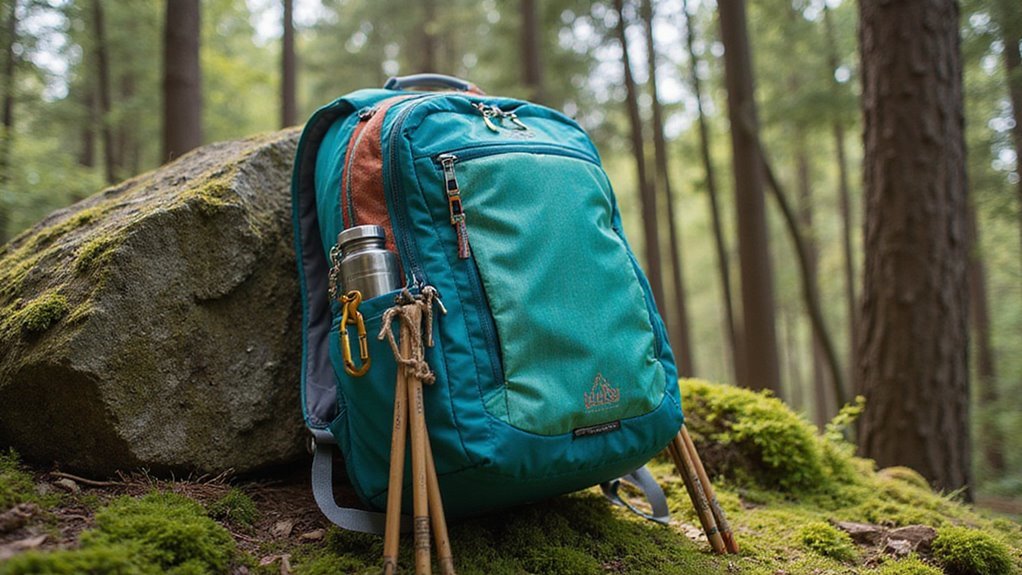
Several powerhouse brands are leading the charge in sustainable hiking gear, proving that eco-friendly doesn’t mean sacrificing performance.
We’re seeing KEEN Footwear donate millions while revolutionizing eco-conscious footwear, and Gregory Packs slash waste by 21% through smarter shipping.
Mammut’s crushing it with their PFC-free Lithium 50, while Big Agnes powers operations with 100% renewable energy.
Let’s not forget Klean Kanteen’s brilliant double-wall designs keeping our drinks just right.
These sustainable products aren’t just good for our outdoor adventures – they’re reshaping how we prioritize sustainability in every step, zip, and sip.
Key Features of Earth-Conscious Hiking Gear
As outdoor enthusiasts increasingly demand sustainable options, today’s eco-conscious hiking gear stands out through five essential features we can’t ignore.
When we’re hitting the trails, our eco-friendly outdoor gear delivers uncompromising performance while protecting what matters most.
- Sustainable materials like recycled polyester and nylon keep plastic waste out of landfills
- Zero harmful chemicals means safer adventures for us and nature
- Ultra-durable construction reduces waste through longer gear life
- Fair labor practices and conservation efforts backed by manufacturer commitments
- Innovations in Dyneema technology are paving the way for lighter and more sustainable options in outdoor gear.
We’re seeing a revolution in how outdoor gear supports environmental impact reduction without sacrificing function.
Smart design meets planet-first thinking.
Durability and Longevity in Green Backpack Design
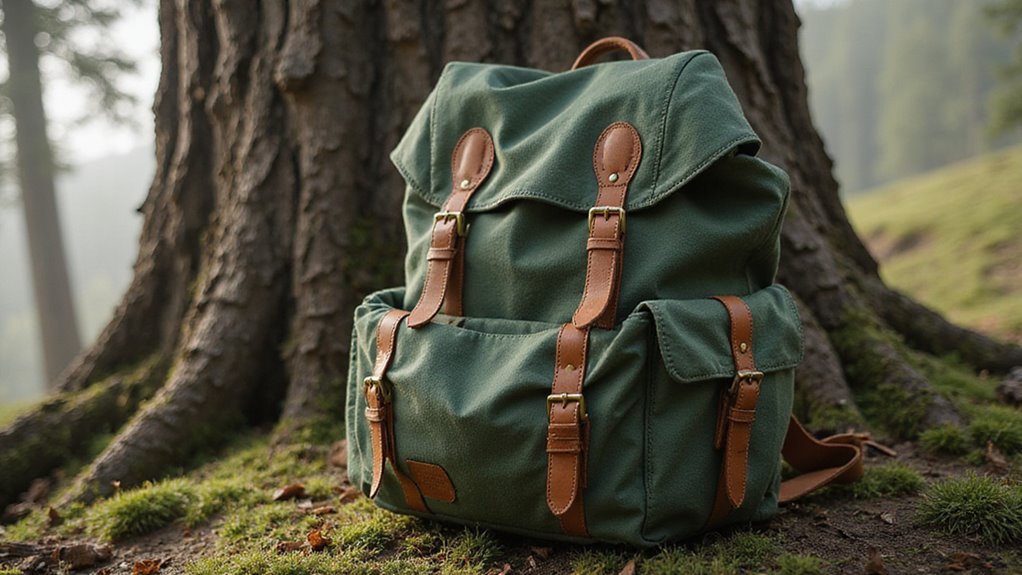
Though sustainable backpacks prioritize eco-friendly materials, they’re engineered to outlast conventional gear through superior construction.
We’re seeing durability emerge as a defining feature of sustainable gear, with recycled materials proving remarkably resilient in rugged conditions.
The exceptional craftsmanship in eco-friendly designs isn’t just about minimizing environmental impact – it’s about maximizing longevity.
Brands back this commitment with solid warranties and repair services, promoting responsible consumption.
When we invest in these packs, we’re getting products built to last, incorporating biodegradable components that perform without compromise. Additionally, the use of premium leather in some sustainable designs showcases an intersection of luxury and eco-consciousness.
That’s smart engineering meeting earth-conscious innovation.
Impact of Recycled Materials on Performance
Recycled materials in modern hiking gear deliver performance that rivals or exceeds traditional virgin materials, while slashing environmental impact by 50%.
We’re seeing sustainable outdoor equipment that’s revolutionizing the industry with remarkable performance characteristics.
- Recycled polyester and nylon maintain durability while minimizing carbon footprint
- Moisture-wicking capabilities match or exceed conventional materials
- Eco-friendly insulation performs identically to traditional alternatives
- Environmentally conscious gear stays lightweight and breathable in all conditions
Let’s be clear: choosing recycled materials doesn’t mean compromising performance.
These materials protect both your adventure and our planet, delivering the technical specifications you need while minimizing harm to the environment.
Choosing Between Sustainable Backpack Options
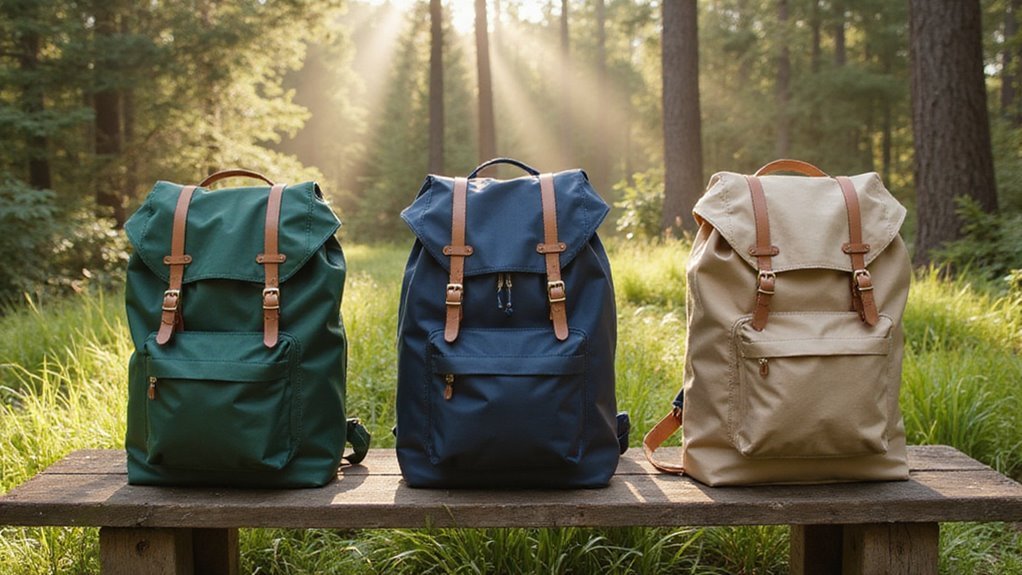
Modern sustainable backpacks don’t just help the planet – they’re engineered to outperform traditional options in every way that matters.
When we’re selecting eco-friendly hiking gear, we’ve got powerhouse options like Gregory’s Juno 24 with its ventilated design and Mammut’s Lithium 50 with PFC-free materials.
Let’s focus on what counts: recycled materials driving performance, manufacturing practices that slash environmental impact, and intelligent design that maximizes function.
Brands like Big Agnes are revolutionizing outdoor clothing production through renewable energy and minimal packaging. Additionally, eco-conscious brands such as Patagonia’s Worn Wear Program encourage repair and recycling over replacement, promoting circular fashion.
We’re not compromising – we’re upgrading to lighter, tougher, smarter gear that’s built for both adventure and preservation.
Cost Considerations for Eco-Friendly Hiking Gear
When considering eco-friendly hiking gear, let’s tackle the price tag head-on – it’s higher up front, and that’s just math.
But here’s where the smart money goes:
- Quality sustainable materials outlast conventional gear by years, spreading cost over time
- Environmental impact reduction through renewable materials and ethical production practices
- Warranty and repair services extend product life, maximizing your investment
- Used gear markets offer budget-friendly entry points to sustainable brands
We’re not just buying gear – we’re investing in durability, ethical production, and ecosystem preservation.
The initial sting fades when you factor in longevity and performance benefits.
Maintaining Your Sustainable Hiking Equipment
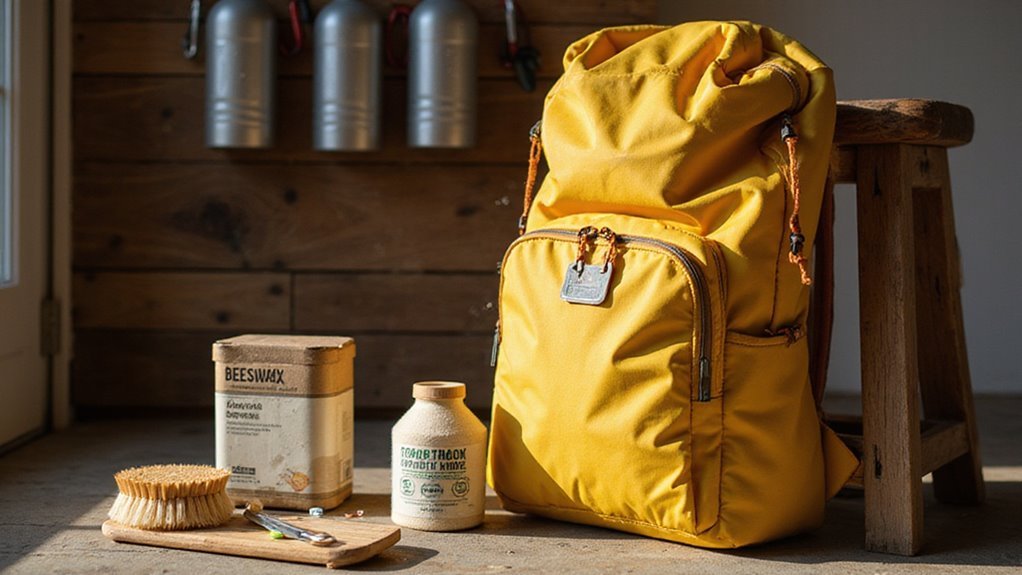
Now that you’ve invested in quality eco-friendly gear, let’s keep it performing at its peak.
We’ll maximize your outdoor equipment’s lifespan through strategic maintenance.
Clean your hiking gear with biodegradable soaps – it’s non-negotiable for sustainability and performance.
Store everything in cool, dry spaces to prevent material degradation.
Regular inspections are essential; catch wear early, repair promptly.
Here’s the kicker: proper maintenance isn’t just about gear longevity.
Every repair extends your equipment’s life, reducing environmental impact.
Many eco-friendly brands offer maintenance services – use them. Additionally, check zippers and hardware regularly to prevent unexpected failures and ensure smooth operation.
Frequently Asked Questions
Why Is Hiking Eco Friendly?
We’re practicing sustainable hiking ethics by embracing nature conservation, using eco-friendly materials, and maintaining minimal footprints. Our responsible adventures protect wildlife while reducing environmental impact through mindful outdoor practices.
Why Is It Good to Use Eco-Friendly Products?
Like nurturing seeds for tomorrow’s garden, we’re choosing sustainable materials and ethical production to reduce our carbon footprint, minimize waste, protect animal welfare, and support renewable resources for a healthier planet.
Why Is Eco-Friendly Design Important?
We need eco-friendly design to reduce our carbon footprint and environmental impact through sustainable materials, ethical sourcing, and biodegradable options while promoting resource conservation and long-lasting durability in a circular economy.
What Is the Most Important Thing to Bring Hiking?
While we cherish nature’s call to adventure, we’ll always prioritize a high-quality backpack to carry our essentials: water supply, trail safety gear, proper footwear, weather protection, navigation tools, first aid, and energy snacks.